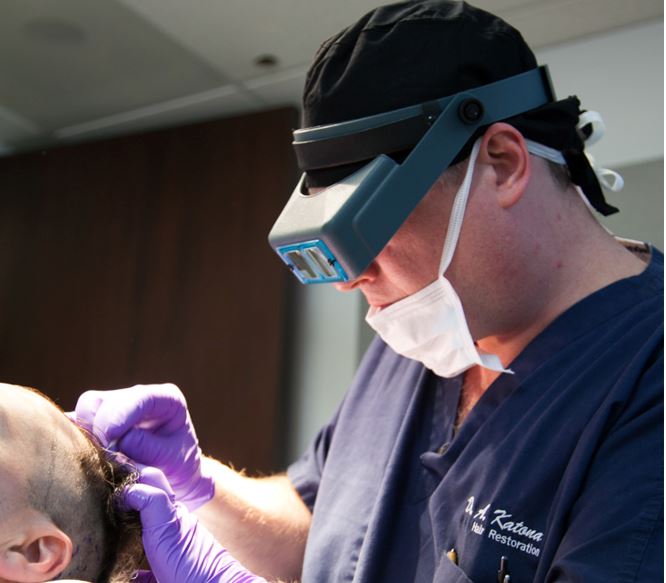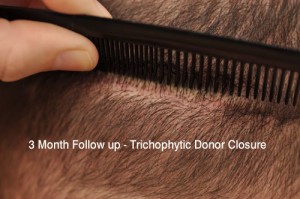Surgical Hair Transplants
Methods of Surgical Hair Transplantation

In the realm of hair transplantation, two techniques stand out: FUT and FUE. Their primary distinction lies in how follicle units are extracted. FUT involves taking a strip of scalp with hairs from the back of the head, extracting its follicles afterward. Conversely, FUE entails directly extracting individual follicular units from the scalp.
Both methods focus on extracting the smallest natural hair groups known as follicular units (FUs), typically comprising 1 – 4 hairs. The extraction process is crucial for hair transplant success, emphasizing the quality of hair roots, pivotal in determining graft viability.
Follicular unit hair transplantation is now the most common surgical treatment for hair loss, continually improving cosmetic outcomes. Experience, scientific advancements, and sophisticated instruments contribute to providing patients with remarkably natural, undetectable results.
Methods of Surgical Hair Transplantation

In the realm of hair transplantation, two techniques stand out: FUT and FUE. Their primary distinction lies in how follicle units are extracted. FUT involves taking a strip of scalp with hairs from the back of the head, extracting its follicles afterward. Conversely, FUE entails directly extracting individual follicular units from the scalp.
Both methods focus on extracting the smallest natural hair groups known as follicular units (FUs), typically comprising 1 – 4 hairs. The extraction process is crucial for hair transplant success, emphasizing the quality of hair roots, pivotal in determining graft viability.
Follicular unit hair transplantation is now the most common surgical treatment for hair loss, continually improving cosmetic outcomes. Experience, scientific advancements, and sophisticated instruments contribute to providing patients with remarkably natural, undetectable results.
Surgical Donor Area and Scarring
The two extraction techniques – FUE and FUT – differ with regard to the scarring left in the donor area. Whereas strip extraction (FUT) will leave a narrow linear scar on the back of the head, all that can be seen after an FUE transplant are micro-scars looking like little dots.
The appearance of the scar in the donor area is therefore a criterion for patients wanting to wear their hair very short. As scarring differs from patient to patient and is also dependent on the type and number of previous and future transplants, the in-depth and well-prepared consultation of a hair surgeon is an absolute “must”. Special closure techniques such as trichophytic closure are beneficial for obtaining minimum scarring after FUT strip extraction.
Surgical Donor Area and Scarring
The two extraction techniques – FUE and FUT – differ with regard to the scarring left in the donor area. Whereas strip extraction (FUT) will leave a narrow linear scar on the back of the head, all that can be seen after an FUE transplant are micro-scars looking like little dots.
The appearance of the scar in the donor area is therefore a criterion for patients wanting to wear their hair very short. As scarring differs from patient to patient and is also dependent on the type and number of previous and future transplants, the in-depth and well-prepared consultation of a hair surgeon is an absolute “must”. Special closure techniques such as trichophytic closure are beneficial for obtaining minimum scarring after FUT strip extraction.
Follicular Unit / Graft Survival Rate
A meticulous approach is essential for ensuring optimal follicle extraction and subsequent survival rates. Grafts extracted via FUE are more sensitive due to the technique’s reduced protective tissue around hair follicles, potentially leading to slightly lower survival rates. Damage to healthy follicles and a poorer rooting rate are risks associated with suboptimal extraction techniques.
Implanting Hair Grafts
Even with optimal extraction, grafts can sustain damage during transplantation, affecting the overall success of the procedure. The incisions made in the recipient area, where grafts are implanted, significantly influence transplantation outcomes. Customized blades enable precise incisions matching the patient’s hair growth direction, facilitating graft connection to blood vessels and nerves for natural-looking results.
Post Hair Transplant Healing
Transplantation is typically performed under local anesthesia, ensuring a pain-free experience. Healing after FUE treatment is faster and generally painless compared to FUT, with reduced swelling and shorter recovery times.
Conclusion on Surgical Hair Transplants
Both FUE and FUT techniques offer promising success rates, each with its own advantages and limitations. The choice of extraction method should be carefully evaluated in consultation with a hair restoration surgeon, considering factors such as future hair loss, existing hair quality and density, and patient preferences. Comprehensive assessments and discussions are essential before recommending a specific technique.
FUE is ideal for patients seeking to avoid linear scarring, younger patients requiring minor treatment, or those with specific hair characteristics. Patients with limited donor hair or a preference for short hairstyles may also benefit from FUE. Combining FUE and FUT techniques may be necessary for patients with extensive hair loss patterns.
At Katona Hair Restoration, we provide comprehensive consultations to determine the most suitable procedure for achieving your hair transplant goals.

